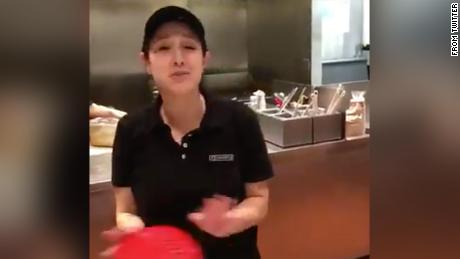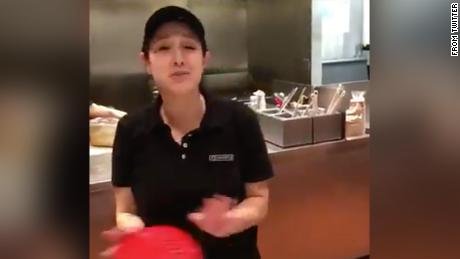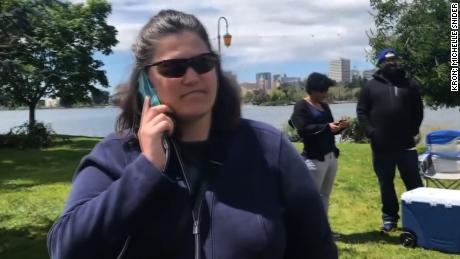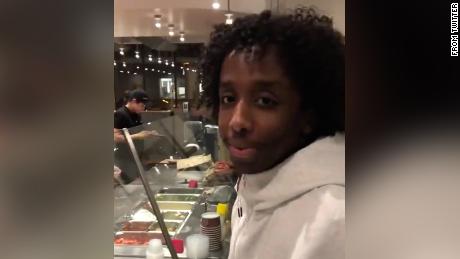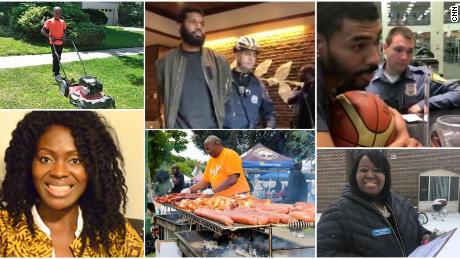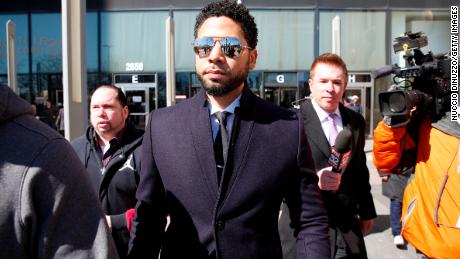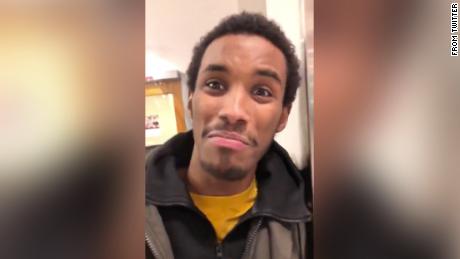“Are you okay?”
“I just wanted you to know there’s a video of you going around with you and this person…”
“Hey, you’re on Twitter.”
Only the night before, Moran was an unknown 23-year-old student in St. Paul, Minnesota. She had moved there from Southern California to attend college on a softball scholarship. Living alone in a new city, she worked at a Chipotle to make ends meet and attended a Lutheran church.
That morning, though, she discovered she had become someone else. Strangers were calling her nasty names on social media. Her photo was plastered across internet news sites. A video was circulating online, and she was its villain. In it, she could be seen refusing to serve a group of black men at the restaurant the previous evening.
Her notoriety spread so quickly that her mother called her from California the next day.
“What happened? What did you do?”
“Slow down,” Moran told her. “There’s a backstory. We’re good.”
But Moran didn’t feel so good after hanging up. Her body went numb. She took deep breaths. She felt a panic attack coming.
She then fell from her chair and collapsed. As she gathered herself on her apartment floor, she reached for the only form of solace she could think of.
She started to pray.
The rise of ambient racism
Just about every week we see the same story. Someone takes a jittery smartphone video of a white person caught in the act of doing something that’s labeled racist. An army of online commentators mobilizes. The video goes viral. And the person in the video is publicly shamed, often losing a job or being ostracized by the community. His or her name becomes a hashtag for hate.
The circulation of these racist outrage videos is so common that they’ve become the online version of background noise. The social scientist Eugenia Siapera says they often trigger “ambient digital racism” — racially toxic online posts from ordinary people that are so commonplace they no longer shock.
Yet there is another part of this story that is rarely told because it is not as common. What happens when you are falsely accused of being a racist in a video? How does your life change after you’ve become a racist meme? How do you handle your own outrage?
For the last six months, Moran has been trying to answer those questions. She was dubbed online as the “racist bitch.” The video of her November confrontation was watched at least 7 million times and re-tweeted at least 30,000 times within two days. The incident was covered by media organizations such as ABC News and Fox News.
Chipotle fired Moran after the video went viral. Soon after that, she would be vindicated. But while the internet mob moved on, she hasn’t.
“Life is really difficult,” she said. “Everything has changed.”
She talks as if she’s experiencing some digitally induced form of post-traumatic stress disorder. Mood swings, anxiety — she sometimes recoils when someone tries to take a smartphone video or picture of her.
In conversation, Moran exudes a mixture of defiance and vulnerability. She often alludes to her faith and says, “God has a plan.” But she doesn’t know what the plan is for her yet. At various times, she’s wanted to be a teacher, a cook and a writer. Introspective and a bit melancholy, Moran draws portraits and writes poetry in her spare time.
Moran says she’s “spent a lot more time alone” because of the viral video. “I don’t really have a desire to meet new people right now. I feel drained of energy.”
Maybe, though, there’s something to be learned from her pain.
It’s been said that a lie will go around the world while truth is pulling its boots on. That adage has never been truer than when an entire online audience is, as one critic put it, perpetually “primed for outrage.”
Could anything have prevented Moran’s public shaming? And why did it spread so quickly when there were warning signs from the beginning?
There were three factors at play that made her story so disturbing — one of which offers at least some hope.
Reason 1: The power of confirmation bias
It started about 10 minutes before closing time on a Thursday night. A group of about a half-dozen young black men walked in, chatting loudly among themselves while aiming smartphone cameras at Chipotle employees.
“They’re back,” one of Moran’s colleagues told her as the men streamed into the food line.
Moran recognized two of them. Only two days before, she said, their credit cards had been declined when they lined up to pay. She had also been warned about them not paying before, and seen video footage of them “dining and dashing.” They had ordered their food in the takeout line, given the cashier a credit card, then dashed with their food after the card was declined.
“You gotta’ pay ’cause you never have money when you come in,” Moran told them.
The men erupted in indignation. At least one started recording.
“She’s making crazy accusations.”
“Y’all racist!”
“We got no money.”
When Moran returned home that night, she was drained. The men made so much noise she had a headache. She called the police twice to defuse the situation, but it seemed like forever before they arrived.
Plus, there was something she says she didn’t want the men to see. When she handed her business card to one of them after police arrived, she said, he laughed and taunted her when he saw her hand.
It was shaking.
“I cried a lot,” she says. “Just kind of broke down.”
Her ordeal was only beginning.
At 9:49 p.m. that night, one of the men posted a video of the confrontation on Twitter. He has not responded to several interview requests from CNN. Along with the video, he posted this caption:
“Can a group of young well established African American [sic] get a bite to eat after a long workout session?”
It went viral. Online commentators pounced. National media picked it up. It fit into a pre-existing narrative. It seemed to be another example of a new form of racial profiling being caught on video.
The social media landscape had been filled with accounts of white people accosting black and brown people in public for everything from wearing white socks at a public pool to barbecuing in a park. Here, it seemed, was another act of public humiliation.
Moran, however, never thought she would be news. She didn’t even think she was actually being filmed.
“I didn’t think they would do what they did,” she said. “It never crossed my mind that it would be about racism.”
It never crossed her mind that her story would go viral either. Moran wasn’t a big social media user at the time. She says she didn’t even have a Twitter account. ” She had stayed away from her phone right after the incident, and when she did hear from friends, she thought interest in the video was confined to St. Paul.
But when her mother called, Moran knew the video had gone national.
“We’re not racist,” she responded after her mother flooded her with questions.
Moran’s mother is still so disturbed by what happened that she declined to speak to CNN for this story. But Moran’s sister, Elizabeth Perez, recalled how their mother reacted to the video.
“I just remember her breaking down,” Perez said. “She cried. She was like, ‘I don’t want people hurting my daughter.’ ”
There were obvious holes, though, in the emerging online narrative. Start with a basic question Perez asked after she noticed the way people kept referring to her sister in online discussions.
“When they said ‘racist white woman,’ I was like, ‘My sister is not white,'” Perez said. “I was just so confused.”
The incident was framed as a white person’s humiliation of black men, but Moran is Mexican-American. Still, many people kept identifying her as white as her story spread.
Why didn’t someone notice she wasn’t white as the video rocketed around social media?
For the same reason so many people were quick to believe Jussie Smollett when the actor reported being attacked by two white men wearing Make American Great Again hats, said Joel Mathis, a columnist for The Week magazine.
It’s called “confirmation bias” — people are predisposed to uncritically accept stories that line up with preexisting beliefs, he says.
Smollett was recently indicted on 16 felony counts of making false police reports — charges later dropped by prosecutors. Smollett still maintains his innocence. In a column about the actor, Mathis wrote:
“We all think we are rational creatures, but the truth is that most of us believe evidence that confirms our beliefs — and filter out contradictory facts. When a story comes along that so neatly fits our preconceived expectations, we’re ready to give it credence, when maybe the best thing to do is exercise a little caution.”
But caution doesn’t get you clicks on the internet. Why pause to see if a sensational video is true when you can quickly post it and get attention with a snarky comment?
Reason 2: The power of internet mob justice
As her video made the rounds on social media, people started stalking Moran on social media. They left messages.
“I hope you never get another job.”
“You racist bitch.”
“You dumb whore.”
Moran choked up when she recalled one social media stalker’s words. She said he threatened to burn her grandmother’s body and send it to her in a bag. Some of the worst threats have since been deleted from users’ accounts.
“I got really afraid. I didn’t know how I felt,” she says. “I was overwhelmed. What does this mean? Why me?”
What would inspire someone to talk to a stranger that way?
It’s because rage has become the fuel of online discourse. Critics accuse President Trump of normalizing racism by referring to Mexican immigrants as “rapists” and African nations as “shithole” countries. But Moran discovered that some people on the left can be just as vicious when they denounce racism.
Their criticism became so relentless that Moran began to wonder if they were right. Maybe she deserved it. An old habit resurfaced.
“I’ve been the type of person to assume guilt, to put myself down and have anxiety and depression and to allow it consume myself,” she said.
Her depression deepened when Chipotle fired her after the video went viral. The decision “broke my heart.”
“I felt embarrassed,” she said. “Nobody wants to be called a racist in front of the world.”
Moran became a victim of what one commentator called “internet mob justice.”
The writer Erik Kain tells the story of a man who snapped a selfie for his kids at a Target store in Australia while standing next to a Darth Vader “May the 4th Be With You” display. Another woman thought he was actually taking a picture of her children. She snapped a photo of the man and posted it on Facebook in hopes the “creep” would be “caught.” Facebook users started calling the man a “pedo.”
It didn’t matter that he was snapping a selfie for his kids. He started to receive death threats. The man’s life was”completely upended” by the mistake, Kain said. But truth is unimportant in online shame culture, Kain wrote, because”whoever is most outraged wins.”
“It goes on and on,” Kain said. “People are accused publicly, called out on social media. Pictures are posted. Rumors are circulated. Jobs are lost and reputations damaged. Sometimes the people being shamed are bad people. But always the shaming circumvents due process, precedes true justice, and serves mainly to inflate the sense of self-importance and egos of its progenitors.”
Still, Moran would get a lucky break. An unlikely person would take on the internet mob for her.
The internet could destroy, but it could also save.
Reason 3: All you need is one person with a question
Two days after her video went viral, Moran got another call from her mother.
“People are on your side now,” she said.
Moran’s reputation was salvaged by a stranger. He decided to ask a question no one else seemed to ask after watching the video.
His name is Andrew Hallwarth, and he is immersed in the internet culture. Hallwarth is a chatty, jovial news junkie who works in supply-chain analytics for a distribution company. He devours news sites and Twitter.
When he first spotted the Chipotle video, the racist angle didn’t make sense.
Moran wasn’t the only person in the video suspicious of the young black men’s intentions, he noted. So were her co-workers, who were all people of color. What were the chances of all of them being racist?
Hallwarth did a quick Google search of the man who first called out Moran on his Twitter page. He discovered that the man had allegedly tweeted several times about dining and dashing at Chipotle and other restaurants.
“That’s when the red flags started going off,” Hallwarth says.
He posted his findings on Twitter and started taking on people accusing Moran of racism. Hallwarth said he couldn’t stand to see Moran “publicly crucified.”
“The internet mob is so powerful,” he says. “For as much good as it can do — in the sense of fundraising and getting the word out — it can destroy, it can manipulate.
“It can literally ruin people’s lives in a matter of seconds.”
Others followed Hallwarth’s lead. An online army formed to take on the mob. Defenders responded to critics with posts displaying the dine and dash tweets.
Someone started an online petition to help Moran get her job back. Another started a GoFundMe page for her. The anger started shifting to the men who called Moran a racist.
At least one person even sent a tweet to the man who posted the original video:
“Yeah thanks for f—ing over the future black people that ACTUALLY will deal with racism. For you to turn this into some sorta joke to ruin this lady’s life is disgusting.”
The media picked up the new narrative. It reprinted the tweets boasting of dining and dashing. It quickly ran a series of stories that seemed to vindicate Moran.
Moran ended up seeing some good in the online world. She has since exchanged messages with Hallwarth. She says they share a Christian faith.
“It was a totally unreal experience that this person had this urge out there just to dig a little deeper,” she said. “He didn’t really have to do that. He did that for a stranger.”
Her experience brightened even more. Chipotle called her. They wanted to know if she wanted her job back.
Moran celebrated — by going to Twitter.
“Racism is a real issue that I do not take lightly,” she posted shortly after starting her account. “Racism must be addressed, but what happened here was just wrong. Falsely accused and in return, cut off from a goal that I worked hard for. Today I was ‘officially’ offered my job back. I’m truly grateful for all support.”
What’s next for Dominique Moran
Moran, however, didn’t accept Chipotle’s offer. She said strangers believed in her more than her former employer.
“They discovered the truth before my own company did,” she says.
When contacted about the incident, Chipotle spokeswoman Laurie Schalow emailed CNN: “Our former manager did not accept an offer for reinstatement. We won’t be commenting further on this matter.”
Moran has moved back to Los Angeles to live with her family. And she’s back in the restaurant business, working part time while studying to sell life and health insurance.
Still, sometimes she wonders: Can people be trusted? Should I even risk taking photos with my family members? What if someone recognizes me in public? She remembers how unsettled she felt when a customer at a clothing store she used to work at recognized her from the video.
There is another question that gnaws at her as well: When a crime is committed, someone is supposed to pay. But where is justice for me?
She has received no apologies from any member of the internet mob that stalked her.
No contrition from the anonymous commentators who branded her a racist, called her names and threatened her safety.
She knows she’s not the only one who’s been falsely labeled a racist.
“There are still people out there who have to continue living with the embarrassment of this thing, and people just go on with their lives,” she says.
Nor will she be the last.
Views: 345


